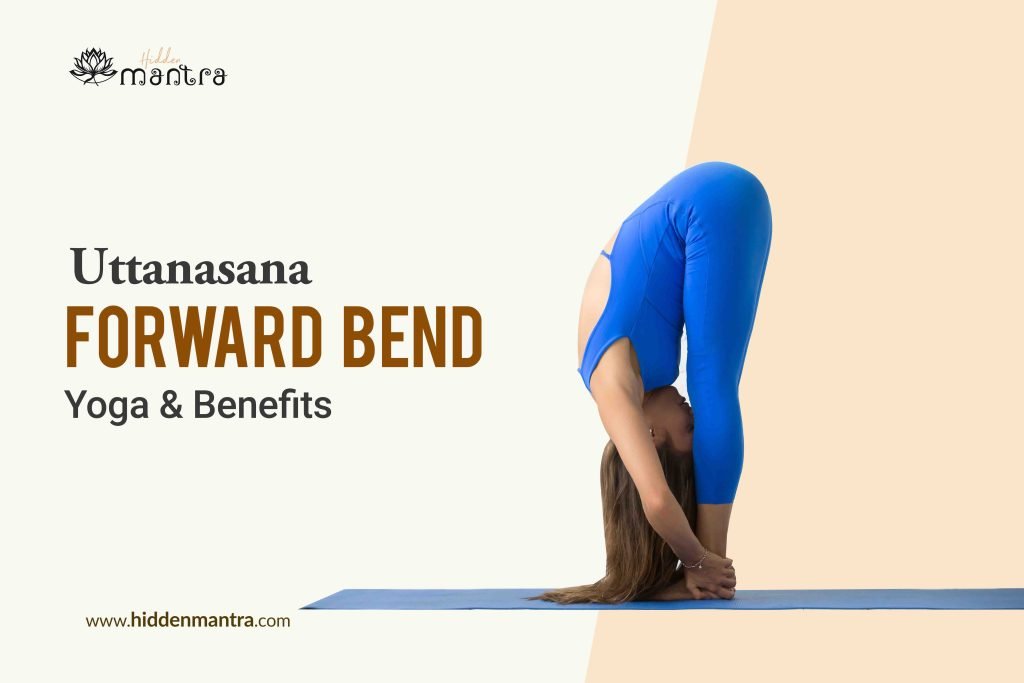Introduction: Uttanasana – The Standing Forward Bend Pose
Welcome to the wonderful world of yoga! Today, we’re going to learn all about a fantastic pose called Uttanasana. It might sound a bit fancy, but don’t worry, it’s super easy to understand and do, no matter who you are!
Uttanasana is the special name for the “Standing Forward Bend” pose in classical yoga. It’s all about bending forward while you’re standing up – and it’s fun to try! So, let’s explore Uttanasana and find out why it’s such a cool pose with lots of benefits for everyone.
Uttanasana Meaning
The term “Uttanasana” is a Sanskrit word used in yoga practice, and it translates to “Standing Forward Bend” in English. Here’s a breakdown of the meaning of Uttanasana:
Uttana
The word “Uttana” (उत्तान) in Sanskrit means “intense” or “stretched out.” In the context of Uttanasana, it signifies the intense stretching of the body in a forward bend.
Asana
The term “Asana” (आसन) means “pose” or “posture.” In yoga, an “asana” refers to a specific physical pose or posture that is practised for various physical, mental, and spiritual benefits.
When you combine these two words, “Uttanasana” essentially means the “Intense Forward Bend Pose.” It’s a yoga pose where you stand upright and then hinge at your hips to fold your upper body forward, reaching toward your legs. Uttanasana is known for its stretching and flexibility benefits. It is commonly practised in yoga sequences as a part of sun salutations or on its own to improve posture and release tension in the spine and hamstrings.
Uttanasana (Forward Bend) Yoga Benefits
Uttanasana is a classic yoga pose that might look simple, but it comes with some fantastic benefits:
1. Body Stretch
- It’s like a gentle tug on your body, stretching your back and legs.
- Your muscles get longer and more flexible.
2. Stress Relief
- Uttanasana is like a mini-vacation for your mind.
- It helps calm your thoughts and makes you feel less stressed
3. Stand Tall
- This pose helps you stand up straighter.
- It’s like a superhero stance for your posture.
4. Happy Tummy
- Uttanasana gives your tummy a little massage.
- It can ease minor tummy troubles.
5. Energy Boost
- It’s like a quick recharge for your body.
- You’ll feel more awake and focused.
6. Sweet Dreams
- Doing this pose before bedtime can lead to peaceful sleep.
- It relaxes your body for a good night’s rest.
7. Super Concentration
- Uttanasana can improve your ability to concentrate.
- It’s like giving your brain a boost for better focus.
Uttanasana might have a fancy name, but it’s a simple way to make your body and mind feel great. Try it out and experience the wonderful benefits!
How to Do Uttanasana (Forward Bend)
Here are step-by-step instructions on how to do Uttanasana (Forward Bend) in a simple and easy-to-follow manner:
How to Do Uttanasana (Forward Bend) Yoga
- Start by standing up straight with your feet hip-width apart.
- Take a deep breath in and raise your arms up toward the ceiling, reaching as high as you can.
- As you exhale, slowly bend your hips and start to lower your upper body forward. Imagine trying to touch your toes.
- Let your arms hang down toward the floor, and keep your back as straight as possible.
- If you can, try to bring your hands to the floor beside your feet. If you can’t touch the floor, that’s okay! You can bend your knees a little to make it easier.
- Relax your neck and let your head hang down. Feel the stretch in your back and the back of your legs.
- Take a few deep breaths in this position, feeling your body relax.
- To come back up, bend your knees slightly and slowly roll up, one vertebra at a time, until you’re standing straight again.
- Take a deep breath and exhale as you lower your arms down by your sides.
Remember to go at your own pace, and don’t force your body into the pose. With practice, you’ll become more flexible and comfortable in Uttanasana. It’s a great way to stretch your body and feel relaxed!
Common Variations of Uttanasana (Forward Bend)
1. Padahastasana (Hands Under Feet)

- After you’ve bent forward in Uttanasana, you can take it a step further.
- Bend your knees slightly and bring your hands under your feet, palms facing up.
- Your toes will rest in your palms. It’s like making a “pocket” with your hands.
- This variation deepens the stretch in your back and hamstrings.
2. Ardha Uttanasana (Half Forward Bend)

- If you’re a beginner or not quite as flexible, this variation is perfect.
- Stand with your feet hip-width apart.
- Instead of bending all the way forward, just bend at your hips until your upper body is parallel to the floor.
- Keep your hands on your shins or thighs, and your back straight.
- This pose still stretches your back and legs but is easier on your hamstrings.
3. Using Props
- Sometimes, it’s helpful to use props like yoga blocks or a chair.
- Place a yoga block under each hand if you can’t reach the floor comfortably. This raises the floor closer to your hands.
- You can also place a chair in front of you, hold its backrest, and bend forward. This gives you stability and support.
These variations make Uttanasana more accessible and adaptable to your level of flexibility and comfort. They’re great options to explore as you progress in your yoga practice. Just remember to go at your own pace and choose the variation that feels best for you.
Precautions
Before practising Uttanasana, it’s important to be aware of the following precautions
- Back Issues – If you have a history of back problems, especially herniated discs or sciatica, approach Uttanasana with caution. Avoid rounding your back excessively, and consider using props or opting for a milder variation.
- Hamstring Injury – Individuals with hamstring injuries should be careful. Bend your knees slightly to reduce strain on the hamstrings, and avoid overstretching.
- High Blood Pressure – If you have high blood pressure, avoid Uttanasana with your head below your heart for an extended period. Instead, try the Half Forward Bend (Ardha Uttanasana) variation.
- Pregnancy – Pregnant individuals should practice Uttanasana with caution and avoid deep forward bends, especially in the later stages of pregnancy. Consider doing a modified version with bent knees or practising under the guidance of a prenatal yoga instructor.
Tips for Practicing Uttanasana
Breathing Techniques:
Uttanasana can be even more effective when you coordinate your breath with the movement. Here’s how:
- Inhale: As you stand tall at the beginning, take a deep breath in through your nose. Feel your chest and belly expand.
- Exhale: As you bend forward, slowly exhale through your mouth or nose. Imagine you’re sighing out any tension in your body.
- Hold Your Breath: While you’re in the forward bend, take a moment to pause and take a couple of breaths. Feel the stretch in your back and legs.
- Inhale Again: When you’re ready to come back up, take another deep breath in as you slowly rise, feeling your chest and belly expand once more.
Coordinating your breath like this helps you stay relaxed and mindful during Uttanasana, making the stretch more effective and enjoyable.
Warm-Up:
Before diving into Uttanasana, it’s a good idea to warm up your body to prevent injury and get the most out of the pose. Here are some suitable warm-up exercises:
- Neck Rolls: Gently roll your head from side to side and then forward and backward to release tension in your neck.
- Shoulder Shrugs: Lift your shoulders up toward your ears and then roll them back and down, repeating a few times.
- Arm Circles: Extend your arms out to the sides and make small circles with them, gradually making the circles larger.
- Standing Forward Fold (Ardha Uttanasana): Practice a half-forward bend to gently stretch your back and hamstrings before attempting the full Uttanasana.
- Leg Swings: Hold onto support and swing one leg forward and backward, then switch to the other leg. This helps warm up your hip joints.
Duration and Frequency:
The duration and frequency of practising Uttanasana can vary from person to person. Here are some general guidelines:
- Duration: Hold Uttanasana for about 30 seconds to 1 minute during each practice session. You can gradually increase this duration as your flexibility improves.
- Frequency: Aim to practice Uttanasana regularly, ideally as part of your daily yoga routine. However, even practising it a few times a week can yield benefits.
Remember, consistency is key. Regular practice will help you gradually deepen your stretch and experience the full benefits of Uttanasana. Listen to your body, and don’t push yourself too hard—progress will come with time and patience.
Personal Experience:
Uttanasana has also been a great teacher of patience and progress. When I first started, I couldn’t touch my toes without bending my knees, and that was perfectly fine. Over time, my hamstrings have become more flexible, and my fingertips now reach the floor effortlessly. It’s a reminder that consistent practice and patience can lead to remarkable growth.
But beyond the physical benefits, Uttanasana has a way of connecting me with my breath and my inner self. The simple act of inhaling and exhaling in this pose brings a sense of calm as if I’m taking a mini-vacation from the hustle and bustle of everyday life. It’s become my go-to pose for grounding and finding inner peace.
As you journey through the world of yoga, I encourage you to explore a variety of poses, including classics like Tadasana (Mountain Pose), Virabhadrasana (Warrior Pose), Trikonasana (Triangle Pose), Bhujangasana (Cobra Pose), Sarvangasana (Shoulder Stand), and even the peaceful Shavasana (Corpse Pose).
Each of these poses has its unique charm and benefits, and they all contribute to your overall well-being. Just like Uttanasana, these poses can become your trusted companions on the path to physical and mental harmony.
For more in-depth insights into these yoga poses and additional guidance, don’t forget to explore the Hidden Mantra blog and its wealth of knowledge. Your yoga journey is a personal one, and with the right guidance and commitment, it can lead you to a more balanced, healthier, and harmonious life. Namaste!









